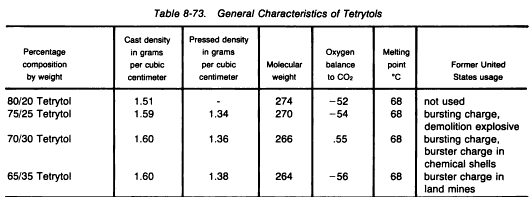Tetrytol on:
[Wikipedia]
[Google]
[Amazon]
Tetrytol is a  Applications of tetrytol are usually military in nature e.g. burster tubes for
Applications of tetrytol are usually military in nature e.g. burster tubes for
high explosive
An explosive (or explosive material) is a reactive substance that contains a great amount of potential energy that can produce an explosion if released suddenly, usually accompanied by the production of light, heat, sound, and pressure. An exp ...
, comprising a mixture of tetryl
2,4,6-Trinitrophenylmethylnitramine commonly referred to as tetryl ( C7 H5 N5 O8) is an explosive compound used to make detonators and explosive booster charges.
Tetryl is a nitramine booster explosive, though its use has been largely superseded ...
and TNT
Trinitrotoluene (), more commonly known as TNT, more specifically 2,4,6-trinitrotoluene, and by its preferred IUPAC name 2-methyl-1,3,5-trinitrobenzene, is a chemical compound with the formula C6H2(NO2)3CH3. TNT is occasionally used as a reagen ...
. Typically, the proportion of ingredients (by weight) is 65%, 70%, 75% or 80% tetryl to 35%, 30%, 25% or 20% TNT. Tetryl and TNT do form a eutectic with a setting point of 67.5 °C, which consists of 55% tetryl and 45% TNT. Hence, cast tetrytol charges consist of solidified suspensions of crystalline tetryl in the solid tetryl-TNT-eutectic. Tetrytol is more sensitive than TNT and less sensitive than tetryl to impact. The detonation velocity
Explosive velocity, also known as detonation velocity or velocity of detonation (VoD), is the velocity at which the shock wave front travels through a detonated explosive. Explosive velocities are always faster than the local speed of sound in t ...
of unconfined cast cylindrical charges (1 inch diameter) of tetrytol is between 7290 and 7410 m/s with an average of 7350 m/s for tetrytol 75/25 and 7340 m/s for tetrytol 65/35. For comparison, cylindrical charges of cast pure TNT of similar dimensions are reported to detonate with a velocity of between 6680 and 6990 m/s.
 Applications of tetrytol are usually military in nature e.g. burster tubes for
Applications of tetrytol are usually military in nature e.g. burster tubes for chemical weapons
A chemical weapon (CW) is a specialized Ammunition, munition that uses chemicals chemical engineering, formulated to inflict death or harm on humans. According to the Organisation for the Prohibition of Chemical Weapons (OPCW), this can be an ...
(e.g. nerve agent
Nerve agents, sometimes also called nerve gases, are a class of organic chemicals that disrupt the mechanisms by which nerves transfer messages to organs. The disruption is caused by the blocking of acetylcholinesterase (AChE), an enzyme that ...
shells), blocks of demolition explosives and cast shaped charge
A shaped charge is an explosive charge shaped to form an explosively formed penetrator (EFP) to focus the effect of the explosive's energy. Different types of shaped charges are used for various purposes such as cutting and forming metal, init ...
s.
Dry tetrytol is compatible with copper, brass, aluminum, magnesium, stainless steel, mild steel coated with acid proof paint and mild steel plated with copper, cadmium, zinc or nickel. Magnesium-aluminum alloys are slightly affected by dry tetrytol. Wet tetrytol is compatible with stainless steel and mild steel coated with acid proof black paint. Copper, brass, aluminum, magnesium, magnesium-aluminum alloy, mild steel and mild steel plated with cadmium, copper, zinc or nickel are slightly affected by wet tetrytol.
When stored below 65 °C (149 °F) Tetrytol does not change stability, acid content, sensitivity or brisance. However, temperatures at 65 °C or above will allow the formation of an oily extrudate and distortion of blocks. Although tetryl undergoes partial decomposition on melting, the melting of tetrytol does not have the same effect. Even when Tetrytol is melted and solidified numerous times it causes no change in freezing point, sensitivity to impact or 100 °C vacuum stability test value.
Tetrytol has been discontinued by the U.S. due to the exudation and low stability at elevated storage temperatures.
References
Explosive chemicals {{Explosive-stub